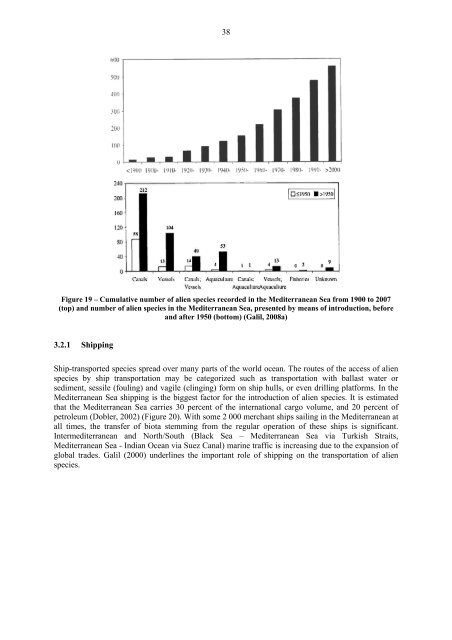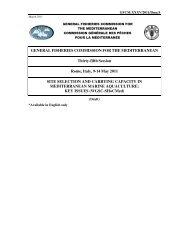Status of alien species in the Mediterranean and Black Sea
Status of alien species in the Mediterranean and Black Sea
Status of alien species in the Mediterranean and Black Sea
Create successful ePaper yourself
Turn your PDF publications into a flip-book with our unique Google optimized e-Paper software.
38<br />
Figure 19 – Cumulative number <strong>of</strong> <strong>alien</strong> <strong>species</strong> recorded <strong>in</strong> <strong>the</strong> <strong>Mediterranean</strong> <strong>Sea</strong> from 1900 to 2007<br />
(top) <strong>and</strong> number <strong>of</strong> <strong>alien</strong> <strong>species</strong> <strong>in</strong> <strong>the</strong> <strong>Mediterranean</strong> <strong>Sea</strong>, presented by means <strong>of</strong> <strong>in</strong>troduction, before<br />
<strong>and</strong> after 1950 (bottom) (Galil, 2008a)<br />
3.2.1 Shipp<strong>in</strong>g<br />
Ship-transported <strong>species</strong> spread over many parts <strong>of</strong> <strong>the</strong> world ocean. The routes <strong>of</strong> <strong>the</strong> access <strong>of</strong> <strong>alien</strong><br />
<strong>species</strong> by ship transportation may be categorized such as transportation with ballast water or<br />
sediment, sessile (foul<strong>in</strong>g) <strong>and</strong> vagile (cl<strong>in</strong>g<strong>in</strong>g) form on ship hulls, or even drill<strong>in</strong>g platforms. In <strong>the</strong><br />
<strong>Mediterranean</strong> <strong>Sea</strong> shipp<strong>in</strong>g is <strong>the</strong> biggest factor for <strong>the</strong> <strong>in</strong>troduction <strong>of</strong> <strong>alien</strong> <strong>species</strong>. It is estimated<br />
that <strong>the</strong> <strong>Mediterranean</strong> <strong>Sea</strong> carries 30 percent <strong>of</strong> <strong>the</strong> <strong>in</strong>ternational cargo volume, <strong>and</strong> 20 percent <strong>of</strong><br />
petroleum (Dobler, 2002) (Figure 20). With some 2 000 merchant ships sail<strong>in</strong>g <strong>in</strong> <strong>the</strong> <strong>Mediterranean</strong> at<br />
all times, <strong>the</strong> transfer <strong>of</strong> biota stemm<strong>in</strong>g from <strong>the</strong> regular operation <strong>of</strong> <strong>the</strong>se ships is significant.<br />
Intermediterranean <strong>and</strong> North/South (<strong>Black</strong> <strong>Sea</strong> – <strong>Mediterranean</strong> <strong>Sea</strong> via Turkish Straits,<br />
<strong>Mediterranean</strong> <strong>Sea</strong> - Indian Ocean via Suez Canal) mar<strong>in</strong>e traffic is <strong>in</strong>creas<strong>in</strong>g due to <strong>the</strong> expansion <strong>of</strong><br />
global trades. Galil (2000) underl<strong>in</strong>es <strong>the</strong> important role <strong>of</strong> shipp<strong>in</strong>g on <strong>the</strong> transportation <strong>of</strong> <strong>alien</strong><br />
<strong>species</strong>.
















